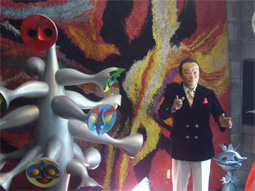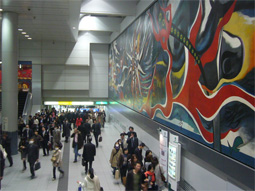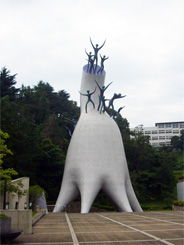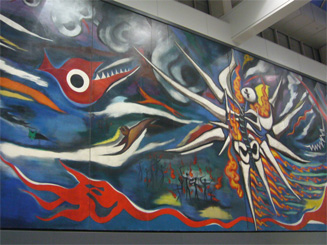 |
|
 |
| Effigy of Mr. Okamoto next to one of his sculptures (courtesy of the Taro Okamoto Memorial Museum, Tokyo) |
|
Commuters passing by the "Myth of Tomorrow" mural in Tokyo's Shibuya Station |
|
Some artists cast such a long shadow that they demand to be reckoned with, whether or not you like their work. Taro Okamoto is one such presence. His impact on the postwar art scene in Japan is multifaceted and impossible to avoid -- all the more so now that his huge, semi-abstract mural of an atomic blast, "Myth of Tomorrow," adorns a major commuter corridor in one of Tokyo's busiest train terminals.
Okamoto (1911-96) was an avant-garde painter and sculptor who was influenced early on by Picasso (he spent ten years studying in Paris before World War II). After the war he developed an interest in prehistoric Jomon artifacts, and elements of both Jomon and Picasso can be seen in much of his work. Perhaps the best known example is "Tower of the Sun," the primitivistic 70-meter-high sculpture he designed as the centerpiece of the 1970 Osaka Expo and the work that put him in the public eye for good. Meanwhile he turned out numerous avant-garde manifestoes and even appeared in a TV commercial that immortalized his most famous statement: "Art is an explosion!"
Today there are two museums devoted to Okamoto's work in the Tokyo area. The Taro Okamoto Memorial Museum, founded in 1998 by his adopted daughter Toshiko, occupies the artist's former home and studio in the fashionable Aoyama district. The Taro Okamoto Museum of Art, a much larger institution that opened a year later, lies just across the Tama River from Tokyo in Kawasaki, Taro's hometown. While the latter museum owns the bulk of Okamoto's work, the former does an attractive job of re-creating the atmosphere of the artist's atelier, complete with a dapper effigy of the man himself.
As of November 2008, however, the go-to Taro location in Tokyo is the Mark City walkway in Shibuya Station. Why this was selected as the venue for displaying what is now Okamoto's most prominent work, a 30-meter long polemic against nuclear weaponry, is a bit of a puzzle. The official explanation is that the site offered the optimum combination of space, public access, and a location en route between the two museums. But one suspects that it was more likely a politically astute move to avoid having to choose between the two atomic-bombed cities of Hiroshima and Nagasaki, which also expressed interest in housing the mural.
"Myth of Tomorrow" itself has a fascinating backstory. Originally created by Okamoto in the late sixties under commission from a Mexico City hotel developer, the mural vanished when the developer went bankrupt. Thirty years passed before it was found in a suburban Mexico City warehouse -- exposed to the elements and in terrible shape -- by Toshiko Okamoto, who spearheaded efforts to bring it back to Japan and restore it. In 2006 the fully restored mural, all 14 tons of it, went on public display in Shiodome, Tokyo, then moved on to the city's Museum of Contemporary Art, before settling into what is presumably a permanent home in Shibuya.
In its new home, the mural looks down upon a ceaseless scurry of commuters, few of whom bother to look up. But perhaps that is just the sort of disjunction that would warm an old avant-gardist's heart.
|
 |
|
 |
| "Tower of the Mother," outdoor sculpture at the Taro Okamoto Museum of Art, Kawasaki |
|
Close-up of the central motif of "Myth of Tomorrow" (Taro Okamoto, 1968-69) |
|